You can survive for roughly 3 days without water.
Fine during normal days in civilization…but what happens during an emergency?
We’ll cover a few of the easiest ways to store & purify water at home and in your car. Plus some alternatives for purifying on the go.
So you’ll have that peace of mind for your family the next time a natural disaster or other emergency strikes.
THE QUICK LIST
-
Best Overall Storage Solution
-
Best Portable Storage Solution
-
Best Water Preserver
-
Most Affordable Emergency Purifier
-
Best Portable Water Filter
Table of Contents
Loading…
Best Water Storage Containers for Emergencies
Now…how much water should you store?
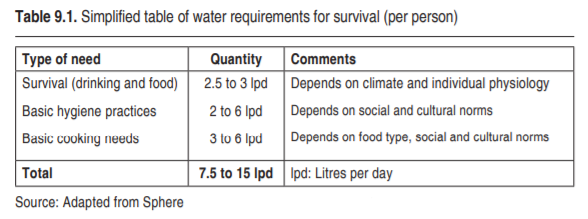
The rough rule of thumb is 1 gallon per person per day. You can go less (like in the chart with 2-3 liters, a gallon is roughly 4 liters), but unless you’re really rationing…it’s gonna suck.
1. 5 Gallon Stackable Containers
For me, with a wife and young child…I’m storing around 30 gallons of water. I’m not prepping for the end of the world…just up to 2 weeks.
I like these 5-gallon stackable containers because they are affordable, save space, and aren’t too heavy.
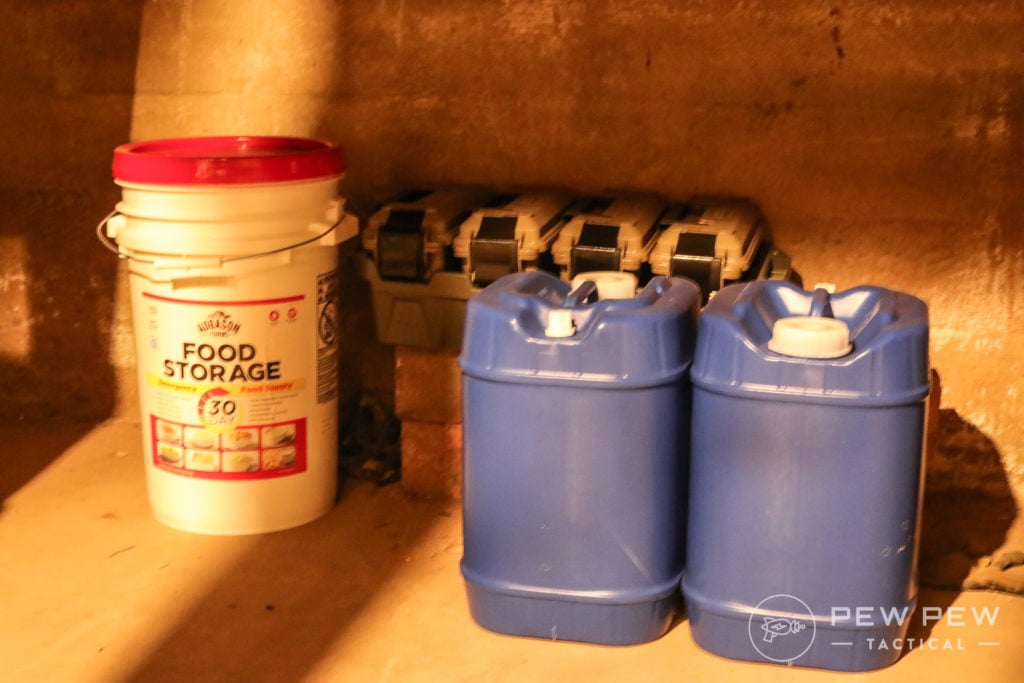
It’s great to have bigger containers, but keep in mind water is about 8 pounds a gallon.
My wife isn’t going to like it…but she can move it if she has to.
Plus, since you’re buying in multiple packs…you can spread them around your property.
-
25% off all OAKLEY products - OAKLEY25
Copied! Visit Merchant
What’s your take on these stackables? Rate them below!
2. 7 Gallon Aqua-Tainer
Slightly more capacity but will weigh more than 56 lbs when full. The Aqua-Tainer is also more robust, so you can use it for camping.
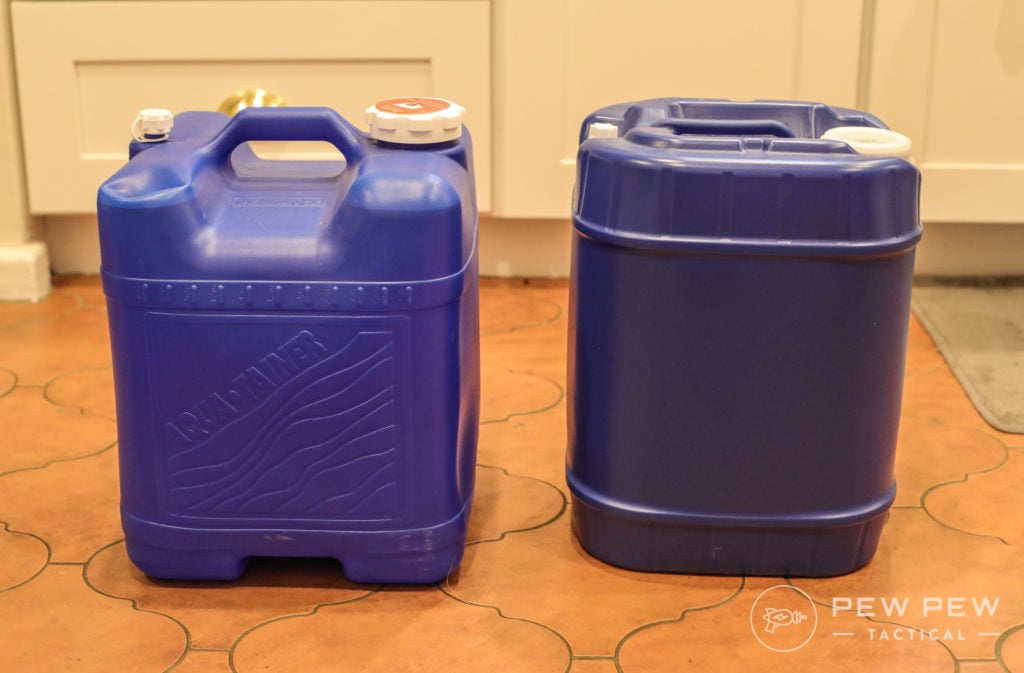
The bad news is you can’t stack it easily if space is an issue. But…per gallon, it’s a better deal than the stackables.
What I did was get the 20-gallon 4-pack of stackables and also two of the 7 gallons Aqua-Tainers in case we need to move with water.
-
25% off all OAKLEY products - OAKLEY25
Copied! Visit Merchant
3. WaterBOB
There’s always going to be that person that says they’ll just fill up their bathtub. Great for a little while…but it’s not sanitary and not covered.
That’s where WaterBOB comes in.
It’s a giant plastic bag with a nozzle where you can fill up to 100 gallons from your tap. Great for when you are able to anticipate an incoming emergency.
-
25% off all OAKLEY products - OAKLEY25
Copied! Visit Merchant
I’m going to get one as a backup…though my major threat is an earthquake which doesn’t necessarily give me a heads up!
If you’d like more reviews on plastic water containers, check out here.
4. Emergency Water Pouches
How about for the car or your office?
You aren’t going to carry around 40+ lbs of water, so that’s where these emergency water pouches come in.
-
25% off all OAKLEY products - OAKLEY25
Copied! Visit Merchant
I first found out about them since they were in my old go-to car emergency kit. They are so convenient I ended up getting a bunch more for the office.
-
25% off all OAKLEY products - OAKLEY25
Copied! Visit Merchant
5. Larger Water Containers
These previous three choices are probably all you’re going to need, but if you have that true prepper mentality…I’ve got some bigger containers for you.
Keep in mind these get heavy when filled and will not be going anywhere…
-
25% off all OAKLEY products - OAKLEY25
Copied! Visit Merchant
If you read enough prepping stuff, you might know you can use your water heater if it has a tank — but I’d still suggest having emergency containers!
How to Purify Your Water
Now that you have the correct amount of water containers, you can’t just throw tap water in there and expect it to last a long time. You’re going to need to purify it somehow.
The easiest is with Water Preserver, which is essentially bleach. Sure, you can use some household bleach…but there are different strengths and other ingredients. Use this Department of Health site to do your research if you go that route.
-
25% off all OAKLEY products - OAKLEY25
Copied! Visit Merchant
I’ll stick with Water Preserver, which is an easy 8 drops per gallon and should keep it good for up to 5 years.
After you do it…remember to mark down the date on the container or cap so you know when to refill it with new water.
Best Survival Water Purifiers
What if you’re on the go and need to purify some water?
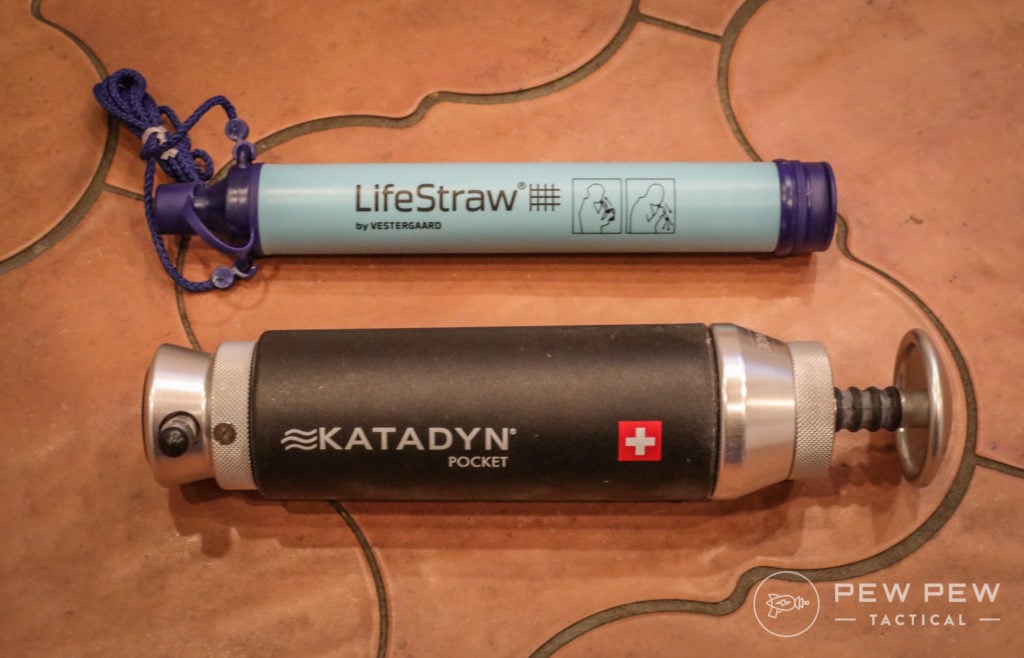
One way is what I use sometimes for backpacking — Water Purification Tablets.
-
25% off all OAKLEY products - OAKLEY25
Copied! Visit Merchant
Or there’s the LifeStraw which lets you suck water from sources and gets rid of all the bad stuff that can make you sick.
Great for a go-bag or car kit where you don’t want all the extra weight of actual water.
-
25% off all OAKLEY products - OAKLEY25
Copied! Visit Merchant
And if you’re an avid hiker or need something more reliable and with more volume for your family, I really like Katadyn. Mine has filtered a lot of scummy water for me and my friends.
The all-metal versions like the one I use aren’t cheap, but the plastic ones are still great for emergency situations.
-
25% off all OAKLEY products - OAKLEY25
Copied! Visit Merchant
We have more suggestions on water filters here!
Final Thoughts
There you have it — the easiest way to store water for your family during an emergency.
My personal favorite is the 5-gallon pack of stackable containers combined with the water preserver drops, but everyone’s needs are different, so choose accordingly.
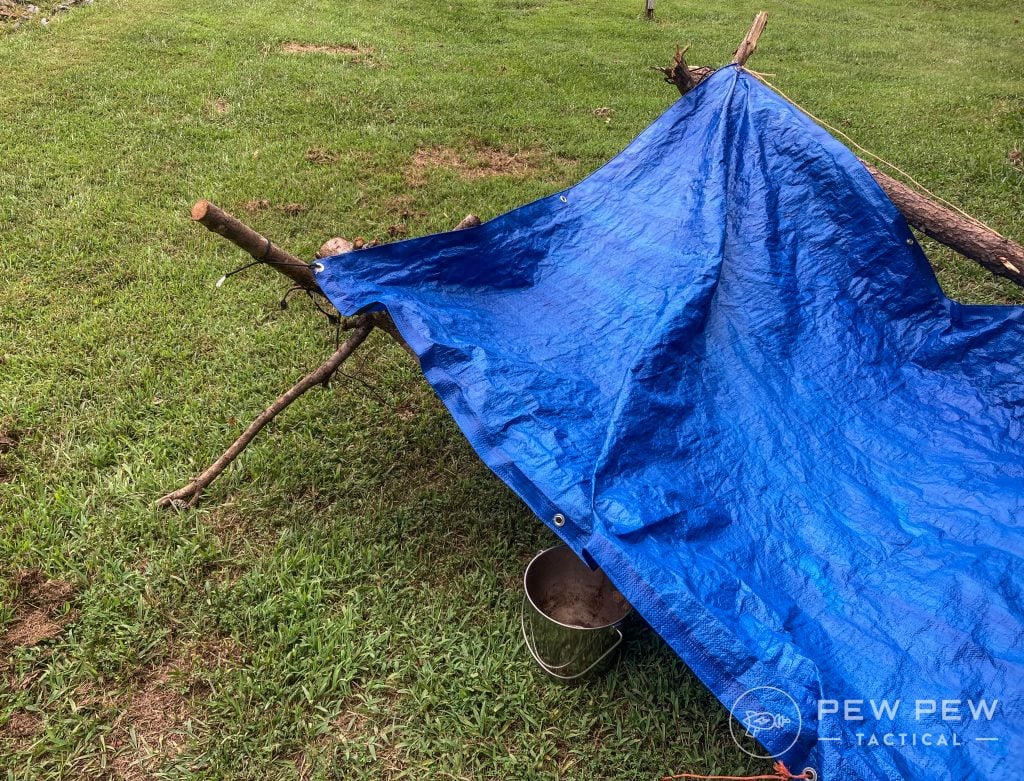
No matter what you go with, remember to purify, keep the containers in different locations, and swap them out every 5 years.
Any other ways you currently store water? Let us know in the comments below. And if you want to go more hardcore, our Essential SHTF Gear List is for you.


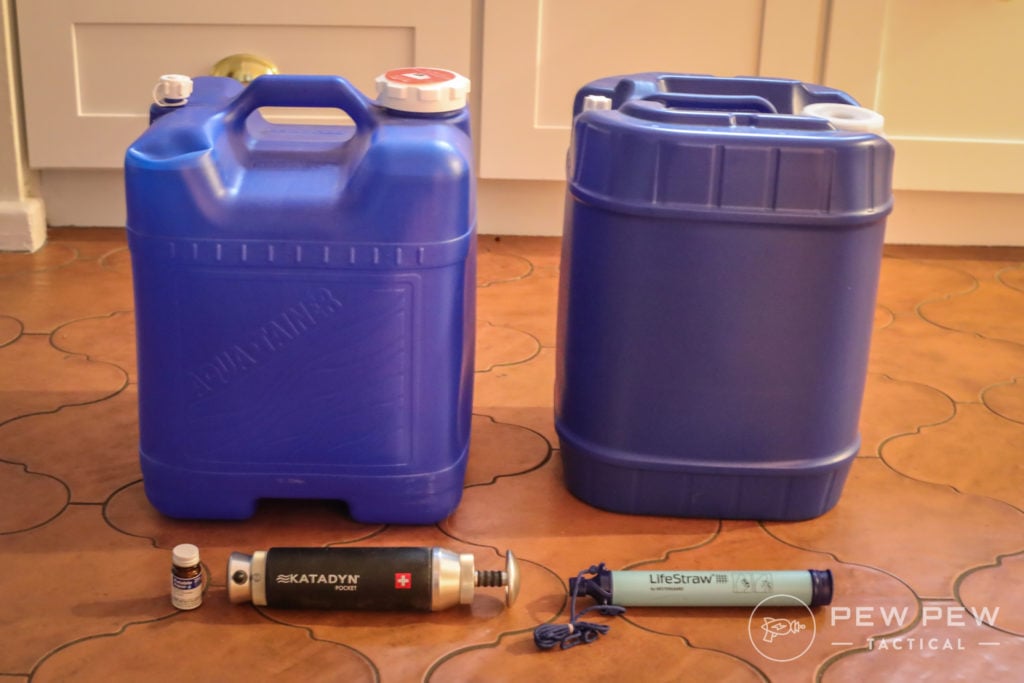




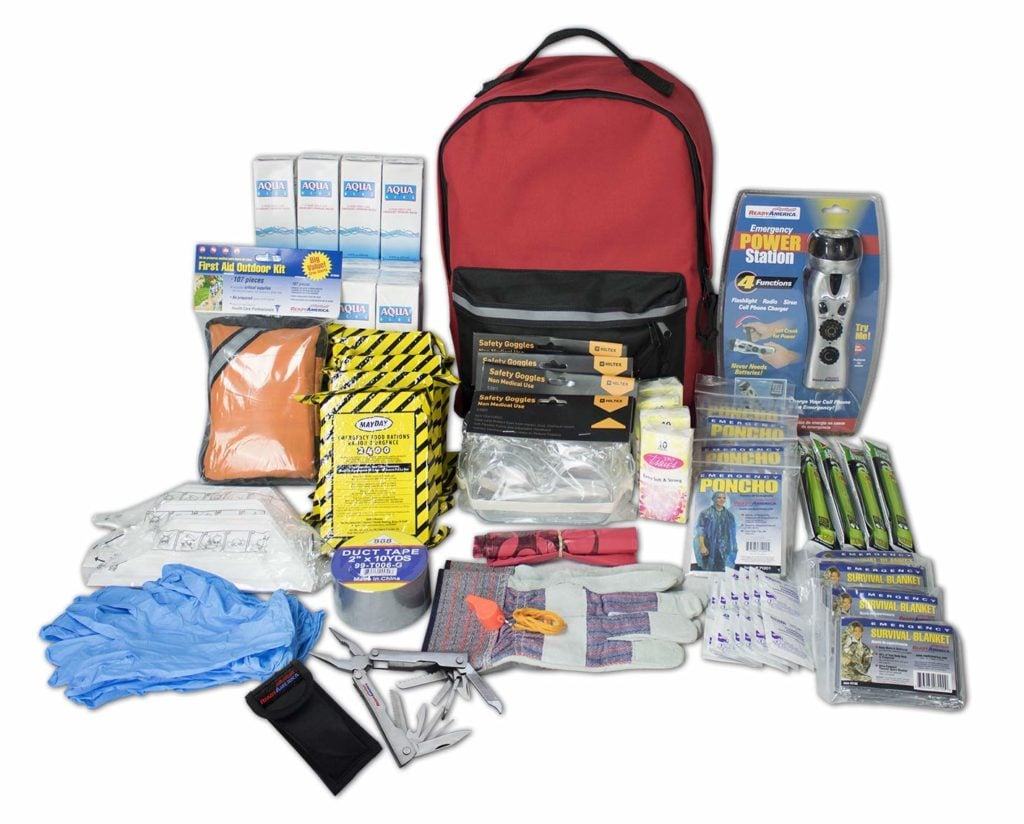







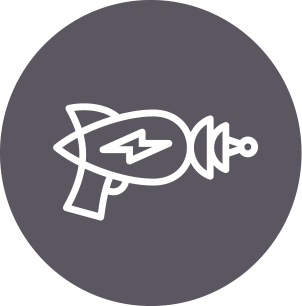
22 Leave a Reply
I've seen a few set-ups using rain barrels, but being round there's wasted space.
A better option are the rectangular wheelie bins that some people use for pressure washers. You can drill a hole near the bottom and add brass or metal fittings. Use t-fittings and you can link them together, just remember to add an overflow at the last bin in your chain.
Each bin is 240 litres so even 3 or 4 gives you a large capacity and because they block the sunlight you have very few issues with algae growing.
If you have the 55 gallon drums (I have 35 gallon ones) don't forget to get a hand pump that can be screwed into the threaded hole on the top. Not having a pump makes getting water out very difficult!
Storage of less than 100 gallons of water can be inexpensive, there are more alternatives out their than camping world containers. The biggest problem is they are too big - having toted my share of 5 gallon military cans (another alternative) you quickly realize that it's problematic. While cost per gallon isn't to be ignored, there are better options to shop.
Waterbricks is one - a smaller container which does stack, will last for years, is easier to handle, can be used camping, and which can also hold other commodities, too. They aren't exactly cheap, but they are highly durable, which the discount store jugs lack over time. Another suggestion are water bottles for a home dispenser, however the industry has a deliberate lack of thread compatibility which creates a disincentive. And the jugs get large and heavy, again.
Water purification is a backpackers serious concern, and vendors like Sawyer have multiple models from single use to camp group sized equipment. If you do have a large storage method - like a 10k swimming pool - then setting up a daily draw for potable water to filter, and using the untreated for baths, toilet, etc allows some luxury.
Until the city issues a boil order or the pumps are down with no power, getting water in town isn't always difficult. For those who live in the country, back up power, well pumps, and the infrastructure needed because you aren't on the grid answers a lot of need.
Since we have really Alkaline Municipal Water in our town, I've been using purified water for a very long time. I keep 10 5 gal bottles on hand, and only use 2 empties to refill at a nearby water/ice machine. $0.25/Gallon for buffered and Reverse Osmosis filtered water.
The 10 sealed are dated and rotated to ensure freshness.
How about this.
I went to Lowes the other day and purchase four 5 gal water jugs - they did not ask for an exchange so it was only $6.99 for each. They are totally sealed and very re-usable.
I still have that I heart kittens patch for ya.
One source of water few people think about is via a dehumidifier. When I run mine I get gallons per day if the humidity is high, like 70% or so. Even on not so humid days I can still get a good bit. The water it pulls out of the air is always crystal clear as well. I would not drink it without purifying it, but I don't think it would take much filtering, if any. Of course you need electricity to run it, but if you are really prepared you will have at least a small generator (or batteries and an inverter) and that is all you need. These things don't draw all that much current. It's as good a reason as any to get a dehumidifier and small generator to make water from thin air. Essentially converting electricity into water.
I have an in home water purification system that uses salt to purify the water throughout my entire house. Would i still need to use the water purification solution when storing it?
The salt is probably taken out before drinking (or if it's a soft water system it's different salt ions)...I'd still purify for storage.
I've used 1-2 gallon containers that use to contain juice or bottled water; the stiffer plastic ones, not milk jugs that dent and wrinkle easily. The purpose wasn't drinking water but water to be used to flush the toilet; if your water is out of order then the toilet isn't refilling automatically. The cost is basically FREE because you were going to recycle or throw those jugs out anyway and they don't also need purification. The only issue is space to store them where they won't freeze. Tip: make sure you have a newer toilet that doesn't need much water. An older 5+ gallon toilet will go thru your water much quicker.
I was going to say nooo, don't reuse those bottles for drinking water! But that's a good point with toilet use.
Open rain barrels collecting off the roof or into a below-ground cistern should be the first line of practical storage, as has been since the beginning of barrel-making. You must boil it first, but it's water with little fuss. Our well has a lot of sulphur. But what you smell is only a few ppm since it is so odorous. Let it vent off by stirring or pouring, then drink. Don't really need a softener.
Thanks for sharing, Marcia...that's pretty hardcore!
You guys are awesome. I just want to say thank you for all the great articles and reviews. Great work!
Thanks Matt!
Full honesty. I only browsed the article plan to read it all later. I didn't see Berkey filters mentioned but that's what i invested in for water purification.
Hey Matt, thanks for mentioning Berkey. I used one for a few years as a better Brita. When we update with best water purifiers they'll definitely be in there. This article is mostly for emergency containers and some portable on-the-go filtration.
I'm confused...you say the aqua-trainers are more expensive that the 5 gallon stackable?
4 stackable = 20 gallons and costs $76.
4 aqua-tainers = 28 gallons and costs $64 (4 x $16).
The aqua-tainer wins, hands down...almost 50% more capacity at about 80% of the cost...
Hey Rich, thanks for doing the math! I must have remembered incorrectly when I did it a few years ago...or the prices have changed a bunch. Fixing article now!
Why not just go with 36 packs of bottled water? It’s inexpensive. From the research that I’ve done, they say bottled water will last indefinitely if stored correctly.
Like Kent, I've been stockpiling the 36 packs of bottled water. They stack on top of each other for storage. Probably not an ideal size of hygiene, but for drinking and cooking, I think they are more convenient than using a large container to draw from.
Hey Kent, good point. I usually have some Costco water bottles for regular drinking and rotate through them. You can certainly keep them for long term as long as they are out of the sun and in a good temperature range. But I'd still rotate them every 6-months since I've definitely had some older water bottles that tasted...off.
Those mini water bottles are great for winter. Don't have to worry about thawing them, just cut open the bottle and drop in the pot for backpacking meals or whatever.